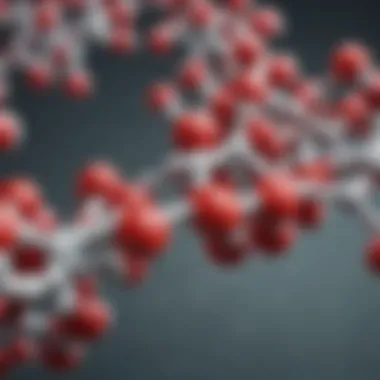Understanding Pepcid's Role in Histamine Blockade


Intro
The exploration of how certain medications interact with biological systems is a fascinating area of study, particularly when it involves understanding histamine blockade. Pepcid, known generically as famotidine, has become significant in treating various conditions linked to excessive stomach acid and allergic reactions. Pepcid functions predominantly as an receptor antagonist, impacting gastric secretions and modulating histamine activity. In this article, we will delve into the nuances of Pepcid's mechanism of action, its therapeutic uses, and the broader implications of histamine blockade in clinical settings.
To grasp the intricacies of how Pepcid operates, it's crucial to begin with a clear understanding of histamine itself and its receptors. Histamine plays several vital roles in the human body, primarily tied to immune responses, gastric acid secretion, and neurotransmission. Broaching the subject of histamine blockade necessitates an examination of how Pepcid interacts at the molecular level, harnessing selective inhibition to mitigate symptoms across various disorders.
This narrative will guide readers through established knowledge and emerging research regarding Pepcid's pharmacological effects while outlining how these findings befit both practitioners and patients alike. Engaging with this content will ultimately illuminate the therapeutic landscape shaped by this powerful histamine blocker.
Foreword to Pepcid and Histamine
When discussing Pepcid, it's vital to appreciate its significance in relation to histamine. Pepcid serves as an essential part of modern medicine, particularly in managing conditions that arise from excessive histamine activity. This article aims to unpack the functions of Pepcid and how it skillfully intervenes in the body's complex biochemical pathways.
Overview of Pepcid
Pepcid, known scientifically as famotidine, is a medication widely prescribed to alleviate conditions brought on by acid overproduction in the stomach.
- Chemical Properties: Structurally, Pepcid belongs to a class of drugs known as blockers, which function by inhibiting the action of histamine at histamine receptors located in the stomach lining.
- Pharmaceutical Development: Introduced in the late 1980s, Pepcid quickly gained traction due to its effectiveness in treating peptic ulcers and gastroesophageal reflux disease (GERD).
- Widespread Usage: Today, it's not just patients battling chronic symptoms of excess acidity who benefit. Even those dealing with allergic conditions find it handy. Such versatility makes it a noteworthy addition to the pharmacological landscape.
The mechanism of action of Pepcid is deeply entwined with the histamine system.
Understanding Histamine Functions
Histamine is a biogenic amine that plays various roles within the human body, acting as a critical player in several physiological processes.
- Immune Response: Within the immune system, it’s notorious for its role in allergic reactions. When the body encounters allergens, histamine release leads to symptoms like swelling, itching, and increased mucus production.
- Gastrointestinal Tract: In the gut, histamine is crucial for stimulating gastric acid secretion. This process is vital for digestion but can become problematic if overexpressed, contributing to ulcers or acid reflux.
- Neurotransmission: Beyond immune functions, histamine also acts on the central nervous system, influencing wakefulness and appetite.
Histamine's double-edged sword nature illustrates why understanding its functions is paramount for effectively managing related disorders.
By comprehending the importance of Pepcid and the roles that histamine plays in various bodily functions, one can appreciate the underlying rationale for its medical applications. This knowledge lays the groundwork for exploring Pepcid's specific mechanisms in the subsequent sections.
Pharmacology of Pepcid
Understanding the pharmacology of Pepcid is crucial for grasping its significance in medical treatments. This section shines a spotlight on several essential components, specifically those that outline how Pepcid operates at a chemical and biological level. The pharmacological profile not only informs practitioners and patients alike about its applications but also enhances the overall comprehension of its role in relation to histamine blockade.
Chemical Composition
Pepcid, with its generic name famotidine, belongs to a class of drugs known as antagonists. The chemical structure is relatively simple yet unique enough to confer its specific action on the body. Famotidine’s molecular formula is C80N8O3S. It consists of a fused imidazole ring and a thiazole ring. This design allows for effective targeting of the histamine receptors in the stomach lining, crucial for its function in reducing gastric acid secretion.
Moreover, the compound is a white, crystalline powder that is soluble in water, which aids in its absorption when taken orally. The clarity of its chemical composition lends itself to a deeper understanding of how it interacts with the various bodily systems. The characteristics of its composition influence its stability and bioavailability, making it a go-to option for treating conditions stemming from excessive stomach acid.
Mechanism of Action
When we discuss the mechanism of action of Pepcid, we're looking at how this medication effectively inhibits the histamine receptors located in the stomach lining. Upon ingestion, famotidine binds to these receptors, effectively blocking them from being activated by histamine. This blockade is vital as histamine typically stimulates these receptors to promote gastric acid secretion.
In practical terms, this translates to reducing gastric acid volume and concentration, which is beneficial for managing a range of conditions characterized by excess acid, such as gastroesophageal reflux disease (GERD) and peptic ulcers. This inhibition is not only a local effect—its action sparks a systemic response where reduced acidity results in less irritation of the stomach lining, allowing for healing and symptom relief.
Key Points:


- Binds to receptors in the stomach.
- Inhibits gastric acid secretion.
- Provides relief for acid-peptic disorders.
Classification as Blocker
Pepcid is classified as an blocker, which is an essential category in pharmacotherapy for gastric acid-related conditions. The term antagonist implies that the drug specifically targets the receptors, standing in contrast to antagonists, which act primarily on allergic responses. Being categorized this way highlights its specialized function in inhibiting gastric secretions.
Comparatively, blockers like Pepcid are an essential part of treatment regimens for various gastrointestinal disorders, particularly when proton pump inhibitors may not be suitable for every patient due to side effects or interactions. Despite their commonality, the blockers have distinct mechanisms and clinical applications which warrant recognition.
In summary, the pharmacology of Pepcid represents a finely tuned approach to tackling gastric acid-related issues through its chemical composition, mechanism of action, and classification as an blocker. Understanding these aspects not only aids healthcare providers in prescribing decisions but also offers patients a better grasp of how their medications work.
"Knowledge of pharmacology and the nuances of specific medications like Pepcid can empower patients and improve outcomes." - Anonymous
Overall, understanding the pharmacology behind Pepcid is important for anyone involved in the treatment of conditions affected by histamine levels.
Histamine Receptors Overview
Understanding histamine receptors is fundamental to comprehending how Pepcid functions effectively in blocking histamine activity. Histamine, a notoriously versatile biogenic amine, plays various crucial roles in physiological processes, ranging from regulating gastric acid secretion to influencing allergic responses. The interplay between histamine and its receptors can dictate a wide array of bodily reactions, so a solid grasp of this interaction is vital for students, researchers, and professionals alike.
The exploration of histamine receptors not only illuminates the pharmacology underpinning Pepcid’s action but also provides insight into the broader implications of histaminergic signaling in human health. More specifically, understanding these receptors can offer valuable perspectives on the therapeutic applications of Pepcid beyond its traditional uses in gastrointestinal disorders.
Types of Histamine Receptors
Histamine exerts its influence via several receptor subtypes engaged in diverse physiological systems. Each type of receptor is configured to bind histamine and trigger different downstream effects. The four primary histamine receptor types are:
- ** Receptors**: Found throughout the body, including in smooth muscles and the central nervous system, these receptors are mainly involved in allergic responses and the regulation of sleep-wake cycles.
- ** Receptors**: Located primarily in the gastric mucosa, these receptors primarily mediate gastric acid secretion, playing a pivotal role in digestive processes.
- ** Receptors**: These receptors are predominantly found in the brain and act as autoreceptors, modulating the release of histamine itself and influencing neurotransmission.
- ** Receptors**: Primarily distributed in the bone marrow and immune cells, receptors are linked to immunological responses and inflammatory processes.
Each receptor type showcases distinct pharmacological characteristics, which are emphasized when applying drugs like Pepcid to target specific reactions and conditions. Therefore, recognizing that these receptors are not just mere targets but integral players in larger physiological networks is crucial as we delve deeper into their mechanisms.
Histamine Interaction with Receptors
When histamine interacts with its receptors, a cascade of events is triggered that can have various effects, often depending on the receptor type involved. For instance, activation of receptors can lead to bronchoconstriction or vasodilation, while activating receptors results in enhanced gastric acid secretion.
Pepcid, as an antagonist, specifically binds to receptors, inhibiting histamine from activating them. By doing this, it prevents excessive gastric acid production, which is essential in managing conditions like gastroesophageal reflux disease and peptic ulcers.
The relationship between histamine and its receptors is complex. Factors such as receptor density, subtype distribution, and even genetic variations can influence how histamine impacts individuals. Here’s a brief overview of how histamine alters physiological functions based on receptor interactions:
- Gastrointestinal Regulation: Histamine binds to receptors, stimulating acid secretion and impacting digestion.
- Allergic Responses: The activation of receptors can lead to symptoms such as itching, swelling, and nasal congestion in allergic reactions.
- Neurological Impacts: receptor activation can modulate neurotransmitter release, influencing sleep patterns and cognitive functions.
Understanding these intricate interactions is not only key to leveraging Pepcid effectively but also to simply grasp the broader histaminergic system. With ongoing research uncovering new facets of these receptors' roles, there’s an exciting landscape ahead for pharmacological innovations.
Pepcid's Role in Blocking Histamine
Understanding Pepcid's role in blocking histamine is crucial for grasping its therapeutic significance in various medical conditions. Pepcid, scientifically known as famotidine, primarily focuses on mitigating the effects of histamine, a compound that plays a pivotal role in the body's response to allergens and inflammation. By effectively inhibiting histamine, Pepcid provides relief to patients suffering from conditions such as gastric disorders and allergic reactions, highlighting its significance in modern medicine.
One of the specific attributes of Pepcid is its ability to selectively bind to receptors in the gastric parietal cells, distinctly decreasing stomach acid production. This not only aids in treating conditions like gastroesophageal reflux disease (GERD) but also significantly reduces the risk of ulcers. The benefits of Pepcid are paramount, especially in contrast to other medications that may be less specific, causing unwanted side effects.
Moreover, by blocking histamine, Pepcid helps to stabilize the inflammatory response during allergic reactions. In situations where histamine release can lead to swelling, itching, or other allergic symptoms, Pepcid serves as a preventative measure, lessening the severity of these symptoms. Its unique action in both reducing gastric acid secretion and moderating histamine effects illustrates how versatile Pepcid can be in addressing multiple concerns in the medical realm.


How Pepcid Inhibits Histamine
Pepcid inhibits histamine through a pretty straightforward process; it competes with histamine for binding sites at the receptor level. When histamine binds to these receptors, it triggers several downstream effects that result in acid secretion and vascular permeability. Essentially, by occupying these receptors, Pepcid prevents histamine from exerting its powers.
The outcome is a marked reduction in gastric acid secretion. Clinical studies have shown that Pepcid can decrease nighttime acid secretion, allowing for a more comforting sleep free from discomfort caused by acid reflux. Additionally, by blunting histamine-mediated effects, Pepcid contributes to symptom management in allergic responses. In allergy contexts, its ability to inhibit histamine helps curb itching and swelling, contributing to an overall feeling of relief for individuals affected by allergies.
Comparative Efficacy of Blockers
When discussing the efficacy of blockers, Pepcid is often lauded as one of the top players in this category. Compared to its counterparts, like ranitidine or cimetidine, Pepcid has been found to exhibit superior potency and a more favorable side effect profile.
- Potency: Research indicates that Pepcid has a more potent inhibition effect on gastric acid secretion than cimetidine, which allows for lower dosages and fewer tablets.
- Side Effects: Unlike cimetidine, which is notorious for its multiple drug interactions, Pepcid presents a much lower risk in terms of interactions, making it a safer choice for individuals on multiple medications.
- Duration of Action: The longer duration of Pepcid means that patients often need to take it less frequently, enhancing adherence.
It's essential for healthcare professionals to weigh the benefits of each blocker, as the choice often depends on the specific patient circumstances and existing health conditions. Pepcid's unique properties usually place it at the forefront of blockers, giving healthcare providers a reliable tool in managing abnormal gastric acid secretion and allergic responses.
"Understanding how medications like Pepcid operate at a biochemical level illuminates their roles in patient care, particularly in preventing complications associated with excessive histamine activity."
Clinical Applications of Pepcid
Pepcid, known generically as famotidine, has found its foothold in a variety of clinical scenarios, primarily due to its role as an effective histamine receptor antagonist. The importance of discussing the clinical applications of Pepcid lies in its wide-ranging implications for treating several health disorders. Pepcid is not merely a medication for heartburn; it plays a crucial role in managing gastric conditions and alleviating allergic reactions, showcasing the versatility that comes from its histamine-blocking capabilities. With a better understanding of these applications, both healthcare providers and patients can make informed choices about its use.
Treatment of Gastric Disorders
Pepcid has made significant strides in the realm of gastroenterology, offering relief to a myriad of gastric diseases. Its ability to inhibit gastric acid secretion means it is often used in the treatment of conditions like gastroesophageal reflux disease (GERD), peptic ulcers, and Zollinger-Ellison syndrome. Here's how it works:
- Reduction of Acid Production: By blocking the receptors in the stomach, Pepcid effectively decreases the amount of acid produced. This is vital for individuals suffering from acid-related disorders since excessive acidity can lead to pain, discomfort, and complications.
- Promotion of Healing: The decreased acidity not only alleviates symptoms but also promotes healing of the stomach lining and esophagus. This can be particularly beneficial for ulcers, where healing can lead to improved quality of life.
- Flexible Dosing: Pepcid comes in both oral and injectable forms, allowing flexibility in treatment. This means it can be administered in outpatient settings or as necessary for hospitalized patients.
With such effectiveness, Pepcid is often preferred due to its relatively favorable side effect profile compared to other acid reducers, like proton pump inhibitors. Notably, patients may experience quicker relief from symptoms, contributing to a better overall treatment experience.
Management of Allergic Reactions
Beyond its role in addressing gastric disorders, Pepcid is also utilized in the management of allergic reactions, thanks to its histamine-blocking properties. For individuals who experience allergies, whether food-related, environmental, or drug-induced, the action of histamine plays a significant role in the body's response. Here’s where Pepcid comes into play:
- Antihistamine Properties: While not a first-line treatment, Pepcid can act as part of the broader strategy for managing allergic responses, especially when combined with other antihistamines like diphenhydramine. By reducing histamine activity, it can help alleviate symptoms like itching, hives, and swelling.
- Administration During Anaphylaxis: Although not a substitute for epinephrine in cases of severe anaphylaxis, there is some emerging evidence that the use of blockers like Pepcid may help decrease the release of histamine from mast cells. This adjunctive use is somewhat controversial and should be approached with caution.
- Minimal Impact on Sedation: A unique advantage of using Pepcid for allergic reactions is that, unlike some older antihistamines, it does not commonly induce drowsiness. This allows patients who may be engaged in daily activities or tasks to manage their symptoms without compromising alertness.
In summary, Pepcid's clinical applications span across various medical conditions, confirming its importance in both gastroenterology and allergy management. By harnessing its ability to block histamine, healthcare providers can offer tailored treatment options that enhance the patient's recovery and quality of life. As research continues, the boundaries of Pepcid's utility may well expand, creating new avenues for its application in modern medical practice.
Adverse Effects and Considerations
Understanding the adverse effects and considerations surrounding the use of Pepcid is crucial when evaluating its therapeutic role. While the medication offers several benefits in managing conditions related to excessive histamine activity, it's equally important to keep an eye on potential side effects and the precautions that come along with its use. Being aware of these factors helps both healthcare providers and patients make informed decisions tailored to individual needs.
Common Side Effects
Pepcid, like many drugs, is not without its side effects. Some of the common ones that users might encounter include:
- Headache: A frequent but usually mild side effect that can sometimes lead to discomfort.
- Dizziness: This can occur, particularly in first-time users, leaving a sense of lightheadedness for a short duration.
- Fatigue: Some individuals may feel unusually tired after taking Pepcid.
- Gastrointestinal Issues: These may range from mild stomach upset to diarrhea, reflecting Pepcid’s effect on stomach acids.
- Skin Reactions: Allergic reactions such as rashes, itchiness, or hives are rare but noteworthy.
While these effects are typically manageable, they serve as a reminder that monitoring one's response to the medication is essential. One should not hesitate to discuss any noticeable symptoms with a healthcare professional.


Precautions and Contraindications
Before starting Pepcid, it is vital to consider various precautions and contraindications. Some important points include:
- History of Allergies: Patients with known allergies to famotidine or any of its components should avoid this medication.
- Kidney Function: For individuals with compromised kidney function, dosage adjustments may be necessary, as the drug’s clearance rates could be affected.
- Pregnancy and Breastfeeding: Pregnant or nursing mothers should consult their doctor before use, as the drug's effects on the fetus or infant aren't fully understood.
- Interactions with Other Medications: Pepcid can interact with certain medications, such as antacids and some antifungals. A thorough medication review is essential to prevent unwanted interactions.
By understanding these potential side effects and the precautions necessary for safe use, individuals can navigate the complexities of Pepcid with greater confidence. Awareness and proactive management are key in ensuring a positive therapeutic experience.
Emerging Research on Pepcid
The discussion surrounding emerging research on Pepcid is pivotal for various reasons, touching upon both clinical and pharmacological fields. Pepcid, known generically as famotidine, has found its niche primarily in the management of gastric disorders and other histamine-mediated conditions. However, as scientists peel back the onion layers of its mechanisms, exciting avenues for its use continue to unfold. This section aims to illuminate some of the noteworthy research trends that underscore Pepcid's evolving role in medicine, particularly beyond what most clinicians conventionally understand.
Novel Uses in Medicine
Recent studies shed light on unexpected areas where Pepcid could offer therapeutic benefits. Originally celebrated for its capabilities as a histamine receptor antagonist, there's growing evidence pointing towards its potential applications in treating various conditions outside the gastrointestinal tract.
- Prevention of NSAID-Induced Ulcers: There is significant research investigating Pepcid's role in preventing ulcers in patients who regularly use non-steroidal anti-inflammatory drugs. These drugs can lead to increased gastric acidity, resulting in harmful effects on the gastric lining. Pepcid's properties may help in mitigating these risks.
- Cardiovascular Health: Some studies suggest that famotidine might influence cardiovascular health by affecting histamine levels, which can play a role in hypertension. More research is required, yet the preliminary findings are intriguing.
Furthermore, early trials have explored Pepcid's effectiveness in treating conditions like chronic urticaria and achlorhydria, highlighting its broader application scope. The cumulative effect of these various studies shows a promising horizon where Pepcid could morph into a multifaceted pharmaceutical agent.
Impact on Neoplastic Conditions
Delving into neoplastic conditions, emerging research suggests that Pepcid could potentially influence cancer treatment outcomes. Some researchers are assessing the drug's impact on tumor growth and metastasis through the modulation of histamine.
- Histamine’s Role in Tumor Biology: Histamine is not just a player in allergic reactions; it also influences tumor growth. The interactions between histamine and its receptors within the tumor microenvironment might create new targets for treatment. The current research indicates that blocking certain histamine receptors can potentially slow down tumor progression.
- Complementing Cancer Therapies: Another focus of current studies is the potential synergistic effects of Pepcid when used alongside traditional chemotherapy regimens. The aim is to enhance the efficacy of existing treatments or reduce their adverse side effects. This could ultimately lead to better patient outcomes and quality of life.
In addition, this area of research raises important considerations for oncologists, who must balance the benefits of adding Pepcid with prospective interactions with ongoing treatments.
"Emerging research is shedding light on the broader implications of Pepcid, urging both clinicians and researchers to reconsider what was once viewed as merely a gastric drug."
In summary, the emerging research surrounding Pepcid goes far beyond its traditional applications. The growing interest in its diverse uses underlines a shift in clinical understanding, highlighting the need for more in-depth studies. As further explorations unfold, Pepcid may increasingly be positioned not just as a treatment option for gastric complaints but also as a versatile player in a broader range of health conditions.
Closure
Understanding the role of Pepcid in blocking histamine is essential for grasping its therapeutic potential in various clinical scenarios. The ability of Pepcid to inhibit histamine receptors provides significant insights into its utilization for treating gastric disorders and managing allergic reactions. Through its mechanisms of action, Pepcid emerges not just as a treatment option but as a vital component in optimizing patient care.
In summary, the major elements of this article highlight that Pepcid's action as an blocker effectively reduces excess stomach acid secretion. This is particularly vital for conditions like gastroesophageal reflux disease (GERD) or peptic ulcers. Additionally, its role in managing allergic reactions underlines its versatility as a medication.
Considerations related to Pepcid also arise when discussing its side effects and implications in neoplastic conditions. Such insights elicit the importance of further investigations into how Pepcid might improve outcomes in a broader spectrum of medical scenarios.
"Pepcid represents a bridge between pharmacology and clinical application, underscoring the nuanced role of histamine in health and disease."
The need for comprehensive studies into the long-term effects and newer therapeutic roles of Pepcid is also evident. Doing so will lay a foundation that not only enhances our understanding of histamine blockade but also enriches treatment frameworks available to healthcare providers.
Summary of Key Points
- Role as Blocker: Pepcid effectively reduces stomach acid production by blocking histamine receptors.
- Therapeutic Application: Primarily used for treating gastric disorders like GERD and peptic ulcers.
- Histamine Interaction: Its role is extended into the management of allergic responses, showcasing its versatility.
- Emerging Research: Investigations are ongoing into Pepcid’s potential applications in neoplastic conditions.
- Future Potential: Consideration of both side effects and contraindications will guide future research efforts.
Future Directions in Research
The future of Pepcid in pharmacology seems promising, with a need to explore novel applications beyond traditional uses. Research could focus on several critical areas:
- Long-term outcomes: Understanding the implications of extended Pepcid use in chronic conditions would help define best practices.
- Combination therapies: Investigating the effectiveness of Pepcid alongside other medications may enhance treatment protocols for complex conditions.
- Patient-specific responses: Analyzing genetic and biochemical factors that influence individual responses to Pepcid could personalize treatment regimens.
- Role in Oncology: Further research into the efficacy of Pepcid in cancer therapies might uncover its impact on tumor progression and patient survival rates.
Engaging in such research would not only enrich the scientific knowledge surrounding Pepcid but also directly impact clinical practices, potentially ushering in new paradigms in the treatment of various diseases.







